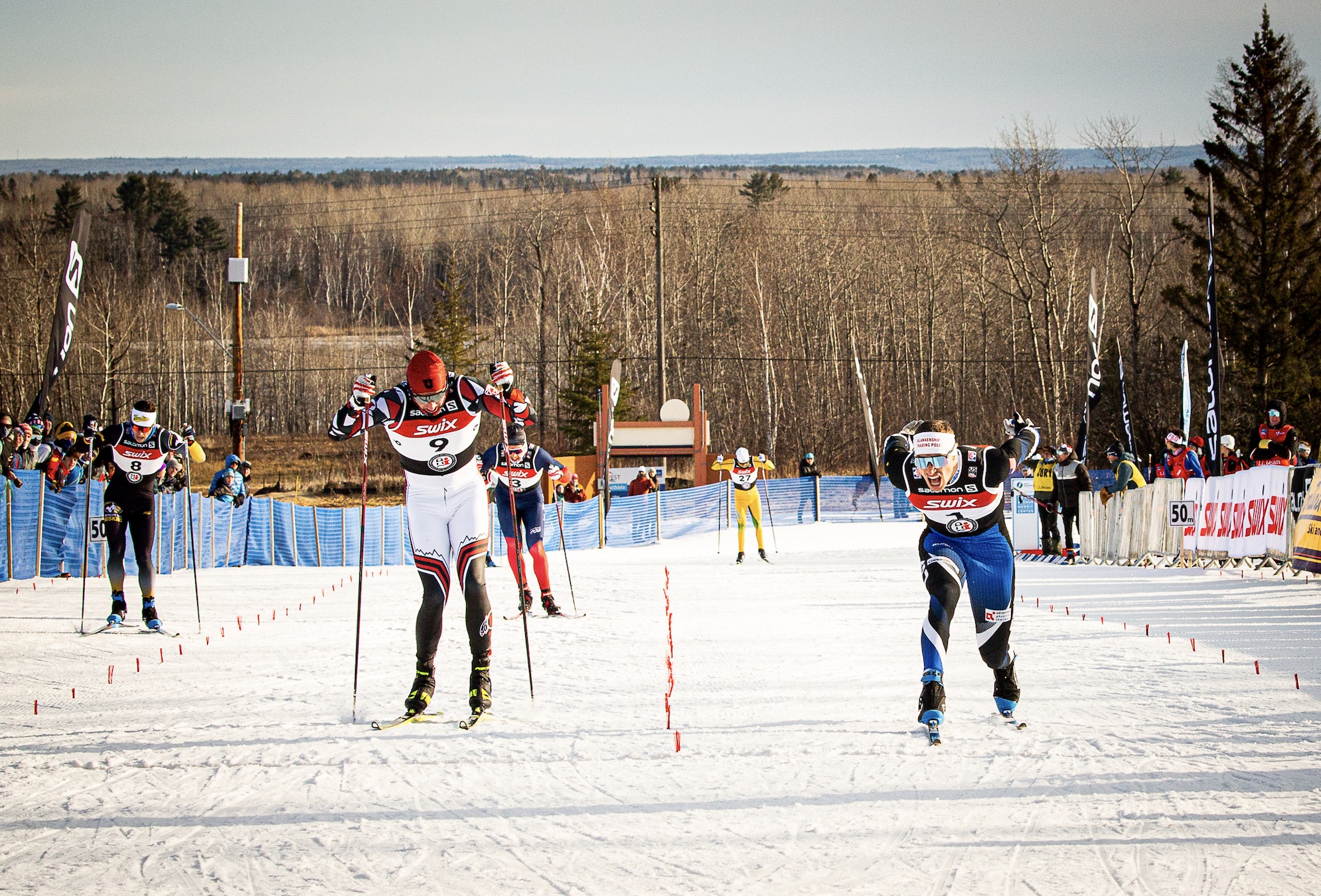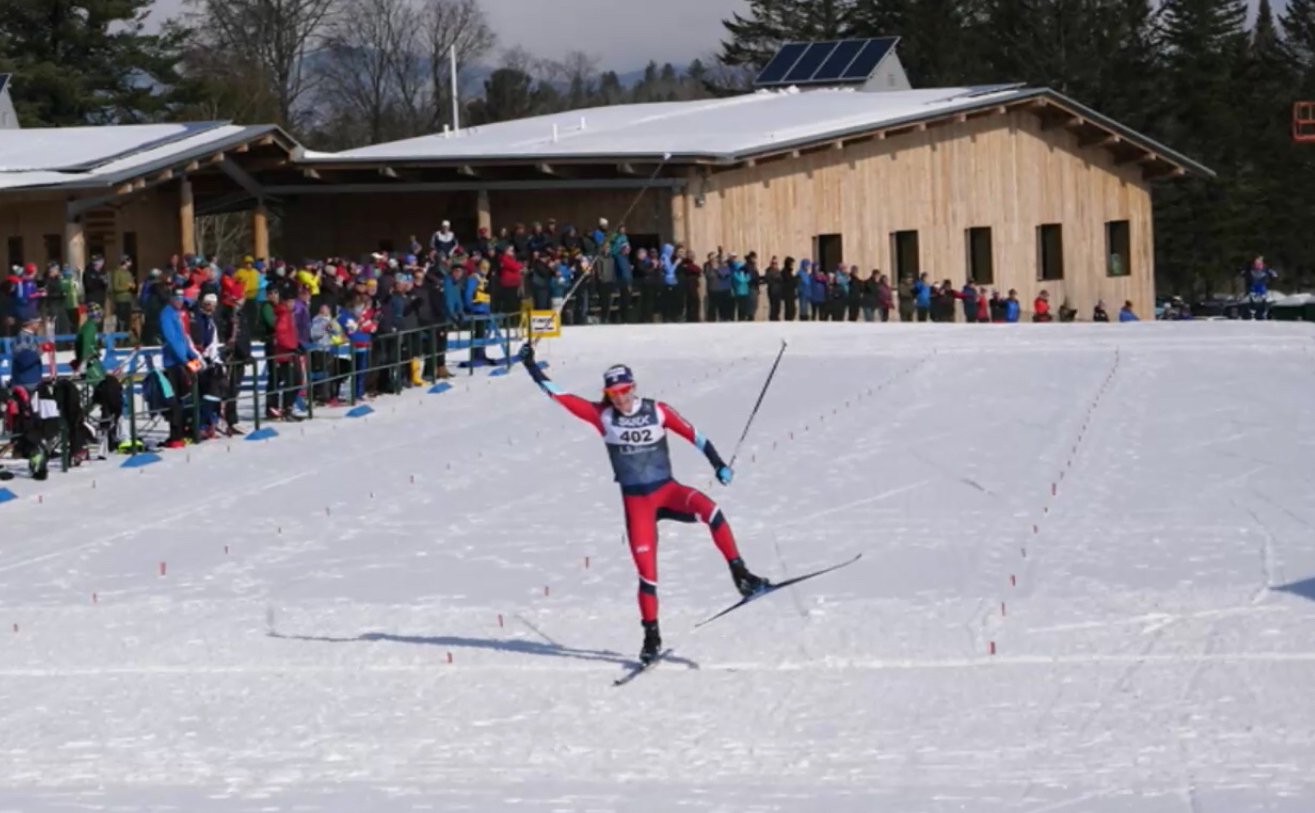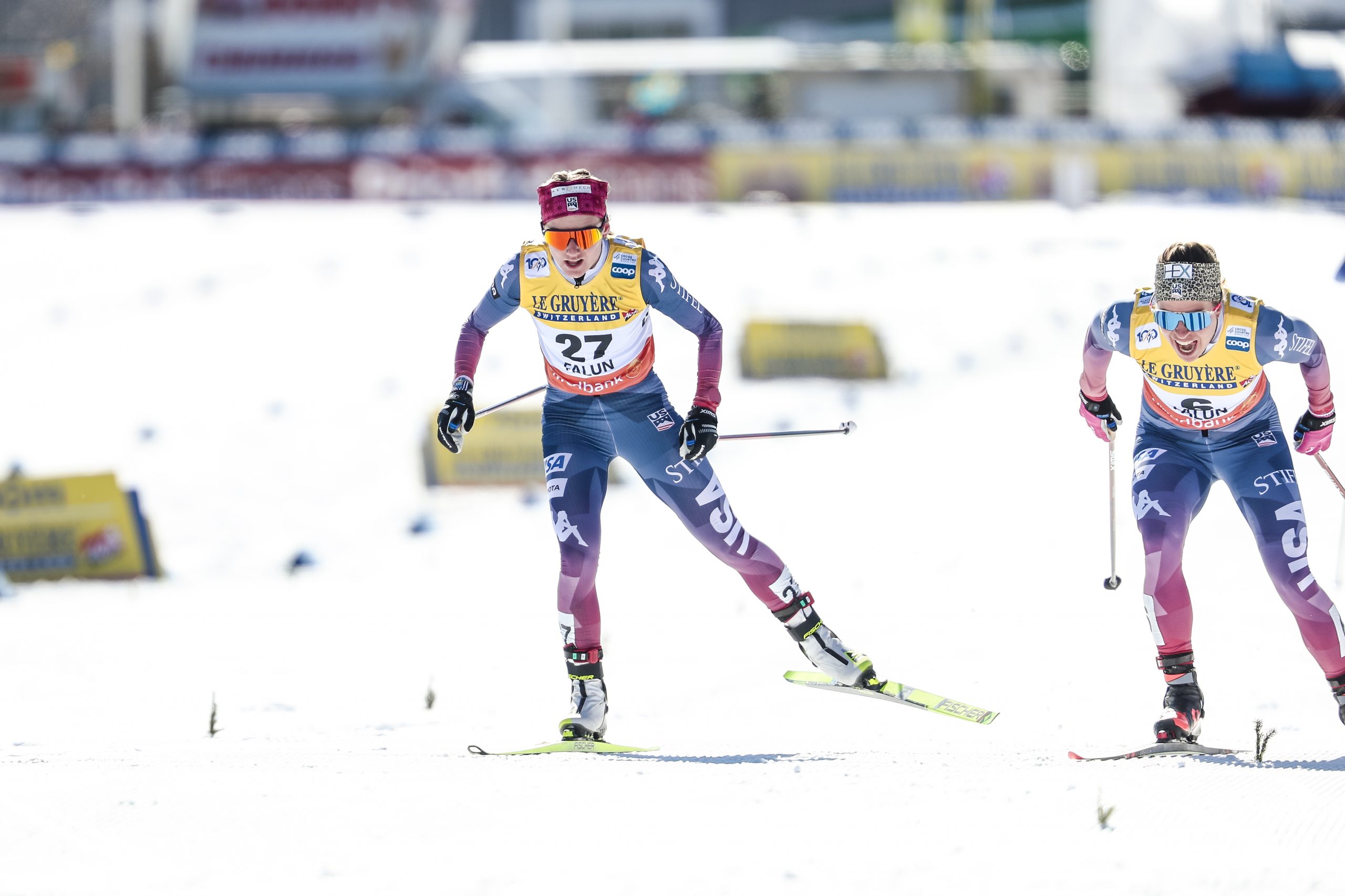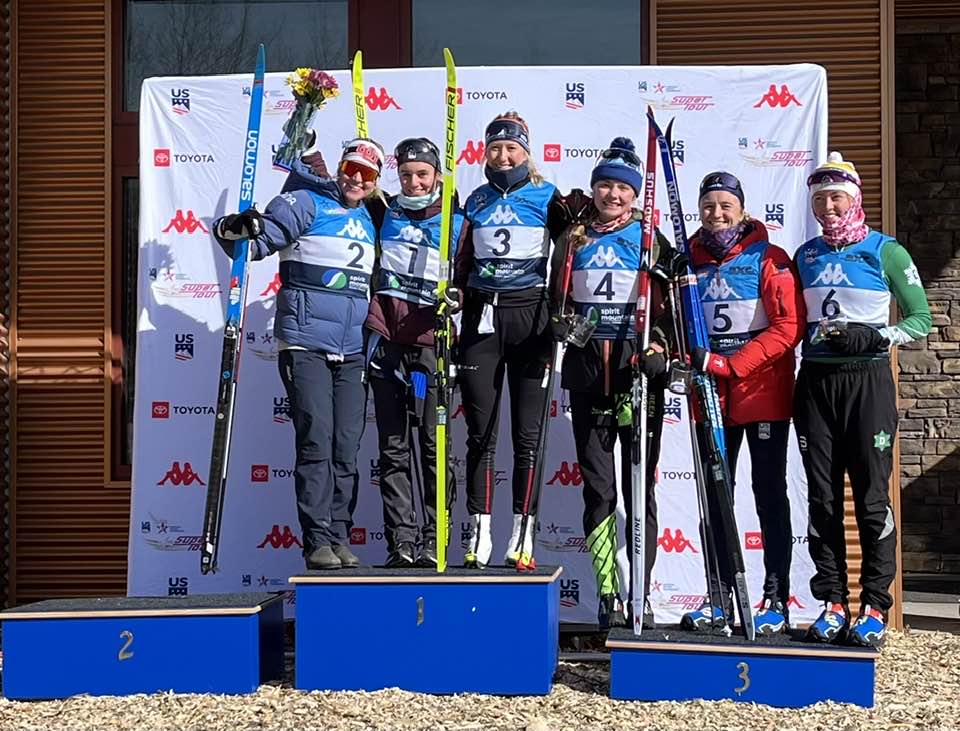
It’s the most welcome irony of the 2023-24 North American ski season so far: As “Spring” Nationals started Thursday at the Spirit Mountain Nordic Center in Duluth, Minnesota, the newly coined “lost winter” of 2023-24 in the Midwest looked to have at-last been found. Snow, from the sky, and not from the end of the snow gun, floated onto that pretty little hillside city near the shores of Lake Superior following the 10 k Classic that opened four days of racing Thursday night. And while racers gathered from across the United States and Canada woke up to a pleasant dusting of white Friday morning, it is looking as if that was simply a opening blip on the story that winter weather will play in the week’s racing, as another storm system looks primed to bring 12-18in of snow, along with some pretty nasty Lake Superior gales (as they say in Duluth, “it’s colder by the Lake!”) right as US Spring Nationals turns towards its finale 40 k on Tuesday.
What exactly are top North American World Cup performers this season, and skiers last seen winning at NCAA Championships, or Junior Nationals doing headed into March conditions that sound eerily reminiscent of the opening verses of the “Wreck of the Edmund Fitzgerald?” They’re all there for the odd, fun, fixture of the US Skiing calendar presently known as SuperTour Finals and Spring Nationals. This is the point where the tensions, travails, and triumphs of the current season start to meet implications for what will happen the next time snow falls on the Midwest (it will fall next year, we can all start to hope!) ahead of the 2024-25 ski season.
Racing started with a 10 k classic on Thursday, with wins from Antoine Cyr (Canadian National Ski Team) in the Men’s race and Novie McCabe (Alaska Pacific University, APU) in the Women’s race, and continued on Saturday with a Classic Sprint won again by McCabe in the Women’s race, and by JC Schoonmaker (APU) in the Men’s race. The program continues on Sunday with a skate Team Sprint, and finishes with a 40 k skate race on Tuesday.
How Did We Get Here? SuperTour Finals and “US Spring Nationals.”
The program being raced in Duluth this weekend is an amalgamation of a lot of ideas that spring from one idea; give the best ski racers in the United States a chance to ski race deeper into the winter.
The traditional bounds of the competitive race season in the United States at all levels have tended to place their ends somewhere in the beginning to middle of March. Athletes who have spent the majority of the winter on the World Cup are back in North America for the first time in months (with this year, and the North American World Cups, a notable exception). NCAA Championships are settled in the first week of March. Junior Nationals takes place around the second week of March.
Yet, most American circuits ending mid-March is an oddity in the scheme of international skiing. The Norwegian National Ski Championships, for example, just kicked off in Lillehammer, and now are held a late-March spot on the calendar to allow and encourage their World Cup athletes to take part (though, it’s worth noting, there is a complicated history on the date of their Nationals as well). A quick survey of the results from Norway on Day 1 of their Championships Friday shows that indeed, their top skiers do take part, as Johannes Hoesflot Klaebo won the Men’s 10 k classic the Men, and Heidi Weng won the Women’s 5 k classic;

Over the years, the US ski community toyed and tested the idea of placing the entirety of US Nationals in late March the same way Norway does it—a particularly brutal run-in with Alaskan winter in January 2009 at US Nationals nearly made it a reality —but the idea has continuously run into the pre-existing idiosyncrasies of the US ski system. For one, holding US Nationals mid-season, as it’s now done every New Year’s week in January, is a weird historical oddity that runs back to when the US Nordic Ski Championships were mainly a ski jumping meet during the formative years of the sport in the 1920s-1930s. As time progressed, the ability to use the mid-season National Championships as a fair method to select everything from World Cup starts to Olympic bids and Junior World Championship Teams became a critical component of US Nationals, and so the idea to move the whole Championships to the Spring was met with muted compromise.
The idea of an end-of-season Nationals persisted in some form, however. Holding a “Spring Series” to allow skiers to continue racing well into March when the other domestic circuits of US Skiing had ceased was a a format tested successfully in the West through the late 1990s and early 2000s (and one set to be revived in Sun Valley and Jackson Hole next weekend), and March, when skiers have raced and trained a whole season, seemed like the best time to gain an accurate measure of abilities at distances that might not make sense in early January. Hence, through much of the last decade, Spring Series marked both the finale of the US SuperTour circuit, and as “Distance Nationals,” capped by a 50 k Men’s race and 30 k Women’s race. Some years, Distance Nationals literally took skiers to the end of the season’s snow, like when Craftsbury, Vermont hosted races amid mid-80 degree temperatures in 2012.
A variety of changes to the program have amalgamated since then. A 4×5 Team Relay was added in 2014. In lieu of a “Distance Nationals,” the US combined with Canadian Nationals, traditionally run at the end of the season, in 2022. All of which is to point out that the format and the importance of the races in Duluth this week are active variables, and that comes as part and parcel of what Spring Series is, a burst of boundary-pushing fun at the end of the season for some of America’s most competitive skiers.
In Duluth, the race program includes four races. The 10 k Classic and Classic Sprint (see below for results and recaps), before a Team Sprint contested by club membership Sunday, and the traditional Distance Championship, now a 40 k skate for both genders, on Tuesday. The final three are considered part of “Spring Nationals.”
What’s at Stake? Settling the Season and Looking Ahead.

Much of the fun in Duluth comes from the perch Spring Nationals holds at the end of the season.
There is a certainty of conclusion. The SuperTour’s Overall winner will be decided by the end of Tuesday. Likewise, the SuperTour’s club competition, the NNF Cup, will be settled, and this year comes with a particularly close race between Alaska Pacific University and the University of Utah to boot. New National Champions will be crowned too.
All those conclusions will necessarily have implications on a winter that’s six months away from now (and will hopefully be snowier in more places!). The winner of the SuperTour Overall has for years been granted start rights for Period I of the next World Cup season (note, at time of writing, this is not confirmed for this season). Current standings show that in the Women’s Overall race, the competition is very close between current leader Margie Freed (Craftsbury Ski Club) and Alayna Sonneysn (Stratton Mountain School T2), separated by just four points. Meanwhile, the final standings are sure to have implications on the discretionary nominations for the US Ski Team to be announced later this spring.
Beyond that, the National Championship status of the final three races of the Duluth weekend, the Classic Sprint, Team Sprint Sunday, and 40 k skate race Tuesday, comes with doubled-prize money over the usual SuperTour totals. The club awarded the NNF Cup also wins a cash prize of $3000 dollars, adding some financial incentive to the proceedings for all club team members.
Who’s Racing and Where to Watch?
The other necessary aspect worth mentioning in the evolution of Spring Series/Spring Nationals is the continued attention to who does, and does not, end up racing it.
Through two days of racing in Duluth, there has been plenty of names that have earned impressive accolades through the course of the season on the start-line in Duluth.

Under sunny skies in Thursday’s 10 k Classic, Canadian National Ski Team’s Antoine Cyr, who’s last World Cup Period included a Sprint Final in Drammen and 11th in the Falun 10 k Classic, won over recent NCAA Champion John Steel Hagenbuch (Dartmouth) in second place, with Zanden McMullen rounding out the podium in third. In the Women’s race, Novie McCabe (APU) followed up her 11th place in the Falun World Cup 20 k with a win ahead of her former UU teammate Sydney Palmer-Leger, with Erin Bianco skiing well back on her home-turf in Northern Minnesota to a third place.
The Saturday classic sprint saw more success for McCabe, who took the win over Bianco, with Alayna Sonneysn (SMS T2) in third place. The Men’s classic sprint was won by JC Schoonmaker (APU) over his teammate Zanden McMullen, with Antoine Cyr rounding out the Overall podium in third, and Zak Ketterson (Team Birkie) in fourth in the final taking the third spot on the US Nationals podium.
The competition then, is there, and there in volumes. The absence of Jessie Diggins, Rosie Brennan, and Ben Ogden, among others, is sure to spark debates about the “National Championship” status of spring series, but it’s also worth noting that the mixed field at the end of a long, grinding season that continues to be more long and grinding at the World Cup level is one ongoing debate that doesn’t look to be settled anytime soon at Spring Series. The Series has always had a distinctly local flare, and a quick glance down the results sheet shows that indeed, the Duluth field leans heavy on Midwesterners.
Absences won’t detract from what is otherwise sure to be on display through the rest of the time in Duluth. As winter blows into the Midwest for the first time this year, some of the best skiers in the country will be tempted to stay with it just a little longer, for American skiing fans to enjoy one last time, as the 2023-24 ski season sends-off by the Big Lake.
LIVESTREAM Sunday’s Team Sprint and Tuesday’s 40 k Skate HERE
Thursday 10 k Classic and Saturday Classic Sprint RESULTS

Ben Theyerl
Ben Theyerl was born into a family now three-generations into nordic ski racing in the US. He grew up skiing for Chippewa Valley Nordic in his native Eau Claire, Wisconsin, before spending four years racing for Colby College in Maine. He currently mixes writing and skiing while based out of Crested Butte, CO, where he coaches the best group of high schoolers one could hope to find.



